HOW-TO, Techniques, & Best Practices Channel
| Star Effects: Enliven Points of Light - How Star Filters Work By Staff posted Dec 1, 2009, 08:51 |
Check out this article in the print edition of StudentFilmmakers Magazine, June 2008. Click here to get a copy and to subscribe >>
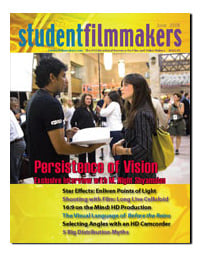 Star
Effects: Enliven Points of Light
Star
Effects: Enliven Points of Light
How Star Filters Work
by Ira Tiffen
Light is the lifeblood of imagery. Without it, imagery dies. Knowing
how to bend light to your will is an important part of visual
storytelling. What can we do when light sources themselves are
actually in the scene? Fortunately, this provides even more opportunities
for creative control.
Let�s look at one category of effect that is particularly suited
for getting the most dramatic effects from points of light in
the scene. We refer to it as the �star� effect.
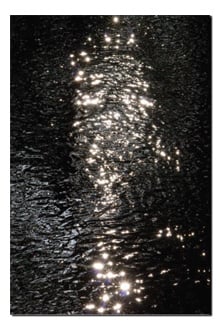
Sparkles, No Filter
Star filters have been around a while. They can be viewed as gimmicky by some. And, if used improperly, that may be the case. However, being able to employ them judiciously can offer significant benefits to many situations.
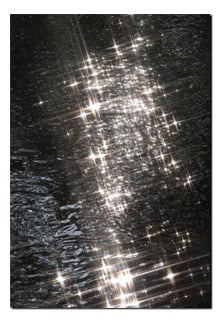
Sparkles with Star Filter
Star filters are excellent for transforming points of light in the scene into bright �starlike� bursts blossoming out from each point. This has many uses, but before we discuss those, it will help us to better understand how they work.
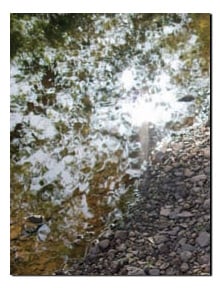
Water�s Edge, No Filter
The traditional Star filter is a clear element, usually glass but not necessarily so, that has a series of fine lines �etched� into one side. These lines act like tiny cylindrical lenses (envision a solid glass polished tube, cut in half lengthwise) that cause the point sources of light to spread out thin fingers of light perpendicular to the direction of the lines, from both sides. A filter with lines, which form a grid pattern across the filter�s surface, usually spaced 1, 2, 3, or 4mm apart, and running in only one direction, will create a single line of light running through a point of light passing through. This is seen as two �star lines� emanating from opposite sides of the source, and aligned in a straight line. This is a �2-point� Star filter; more commonly known as a �Streak� filter, due to its appearance as a streak of light through the source.
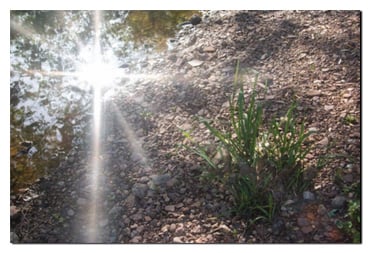 Water�s Edge with Star Filter Combo at F4 |
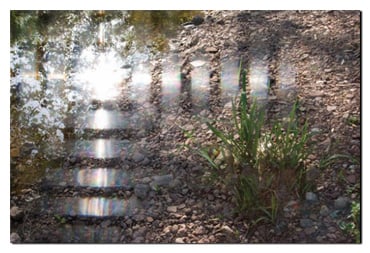 Water�s Edge with Star Filter at F16 |
If the filter has more sets of parallel line grids running in
different directions, there will be an additional set of �streaks�
for each direction there is a grid running. Typically, there are
patterns to produce 4, 6, 8 and more points, in a symmetrical
pattern, in addition to the Streak filter. The most commonly used
filter is the 4pt.
The spacing between lines in a grid, mentioned earlier as measured
in millimeters, determines how many lines there are on the filter.
The 1mm, being closely spaced, will have twice as many lines,
for instance, as a 2mm filter, and will thus create a stronger
star pattern. This also created the most flare. If you want overpowering
stars, use a closer spacing; more finely crafted star points come
from larger line spacing in the grid. The most popular spacing
are the 2mm and 3mm.
Some filters have asymmetrical patterns; they also involve grids
having different line spacing in the same filter. These are designed
to give a less �synthetic� feel to the effect, more like a gleam
or a glint than a star.
I created a number of these years ago in response to the requests
of those who were not using traditional Star filters because of
their �man-made� look.
The �man-made� look of the standard patterns is very effective,
though, when the need for glitter is apparent. These are used
extensively in sports arenas where the lights overhead add excitement
when �starred.� Religious programs, as with a speaker in front
of an audience in an auditorium, often use them to extend the
light into the room, adding an important psychological effect.
The star lines created by these filters also take on the color
of the source. When there are variously colored sources, these
filters have even more impact. Theatrical events and many others
can benefit as well � wherever there are strong points of light.
Star effects don�t have to come directly from point sources. They
are effective with bright points of reflection. This application
includes anything sparkly that could use a touch of glamour: jewelry,
cars, and other shiny things that reflect bright points of light
that would be enhanced by such gleaming touches.
It is clear that anywhere there are bright points of light against
a relatively dark background, Star filters can have a wonderful
effect. There are things to know about their use, though, before
you start experimenting.
As with any other �patterned� filter, it is possible, with sufficient
depth-of-field, to partially focus on the line pattern. This will
appear as a waffle-like grid, the pattern on the filter, appearing
fuzzily in the image. To avoid this, it is best to use larger
iris openings and longer focal lengths, both of which will reduce
the ability of the camera to focus on something mounted right
on the lens, as will focusing on a subject that is further away
from the camera.
In our image examples, there are two scenes. The unfiltered �Sparkles� image shows the sun�s many reflective points from the water�s rippled surface as we would see it. The addition of a 4pt 2mm Star filter creates a galaxy of stars from the same scene; ever so much more interesting. Note that most Star filters are mounted to allow you to rotate the filter to best align the star pattern with your scene.
In the �Water�s Edge� scenes, we see in the unfiltered image again what we would ourselves see. With the 4pt filter and a lens opening of 16 we can see the result of focusing on the filter�s grid pattern. The lines of light are broken up into disjointed segments, very distracting and not at all desirable.
In the last image, using both the 4pt filter as before and a Vector Star filter, one of those asymmetrically patterned filters I mentioned earlier, a clean and commanding star is created by using a lens opening of 4.
Star effects are another powerful way to add excitement and glamour
to any scene containing bright points of light. Especially if
you know how they do what they do. Have fun experimenting!
Photos by Ira Tiffen.
This article may not be reprinted in print
or internet publications without express permission of StudentFilmmakers.com.
Photos may not be copied or reproduced.
Check out this article in the June 2008 print edition of StudentFilmmakers magazine, page 44. Click here to get a copy of the June 2008 Edition, so you can read and enjoy all of the excellent articles inside.
About the Author:
 In
over 30 years of making optical filters, Ira Tiffen created the
Pro-Mist, Soft/FX, Ultra Contrast, GlimmerGlass, and others, netting
him both a Technical Achievement Award from the Academy of Motion
Picture Arts and Sciences and a Prime-Time Emmy Award. Elected
a Fellow of the SMPTE in 2002, he is also an Associate member
of the ASC, and the author of the filter section of the American
Cinematographer Manual.
In
over 30 years of making optical filters, Ira Tiffen created the
Pro-Mist, Soft/FX, Ultra Contrast, GlimmerGlass, and others, netting
him both a Technical Achievement Award from the Academy of Motion
Picture Arts and Sciences and a Prime-Time Emmy Award. Elected
a Fellow of the SMPTE in 2002, he is also an Associate member
of the ASC, and the author of the filter section of the American
Cinematographer Manual.
Resources:
About StudentFilmmakers Magazine & StudentFilmmakers.com >>
Join the Film and Digital Networking Community >>
Post Your Films, Videos, Reels, and Trailers >>
Discuss Motion Picture Techniques in the Online Industry Forums >>
Get the StudentFilmmakers.com E-Newsletter >>
StudentFilmmakers magazine would like to hear from you!
Click here to share your comments and feedback about the magazine, monthly editions, your favorite articles, and your favorite topics.
We always welcome and appreciate your Reader Comments. View them here, and send yours to the editorial team today!